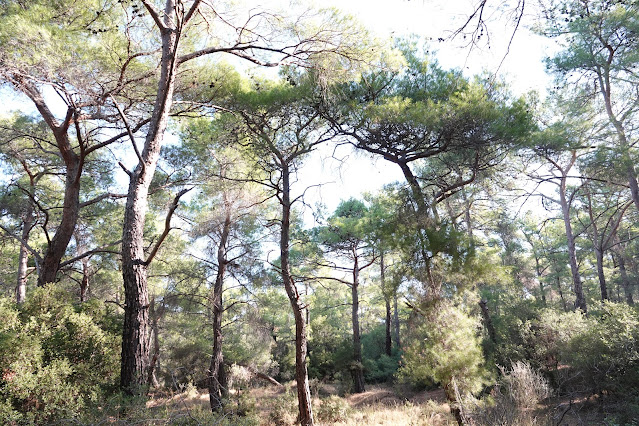Tree Pipits were moving over the Pela during breakfast and I
had counted 17 before we headed out for the day. Achladeri was the first stop
and it was already in the high twenties by the time we arrived before 9.30.
I took a solitary amble up into the woods and it did not
take long to find the Kruper’s Nuthatches. There was a bit of calling and some
chattering but most of the time I could hear them tapping pine seeds that they
had extracted and excellent views were had albeit up in the pine canopy.
 |
| Kruper’s Nuthatch |
 |
| Kruper’s Nuthatch |
 |
| Kruper’s Nuthatch |
Cirl Buntings and Chaffinches were moving around and I heard
Woodlark, Middle Spotted Woodpecker, Sardinian Warblers and Short-toed
Treecreepers but as usual seeing the birds was more challenging. Two parties of Medium Tailed Tits (sorry)
were found and I do love their little black bibs and more chattery calls. I actually encountered them all morning and
heard them from the car on several occasions as we drove through the pine
forests.
 |
| Freyer's Grayling I reckon |
We took the beach road from there and followed it around the
coast with just a Great White Egret for our troubles until the little nameless
harbour where as expected there were Med Gulls with 21 on the rocks with eight
Black-headed Gulls. A Common Sandpiper bobbed amongst them and 11 Mediterranean
Shags were up on the rocks. Even the adults seem to have paler feet than
northern birds and to my eye the bill looks longer too.
 |
| Mediterranean Shags |
 |
| Mostly Meds |
There were not many small birds out here with just the odd
one or two of the usual triumvirate of Red-backed Shrike, Spotted Flycatcher
and Willow Warbler. Down at the Poly
Pans there was a good display by some very pink Flamingos, nine shiny Black
Storks and a selection of waders with ten Redshank, 120 Avocet, Curlew
Sandpiper, three Dunlin, 18 Little Stint and a single Grey Plover. There were
42 Sandwich Terns on the posts with two more Med Gulls and four Slender-billed
Gulls. Twelve Ruddy Shelduck circled in and then disappeared back to the south.
.jpg) |
| Some groves already had the nets out for the Olive harvest |
 |
| Black Storks |
 |
| Ruddy Shelduck |
 |
| Ruddy Shelduck |
 |
| Greater Flamingos |
 |
| Avocets |
 |
| Slender-billed Gull |
We looped back up into the cool woods adding roadside Wren
on the way before lunch at the Evertaglous (sure I have spelt that wrong
again). Kingfishers and Grey Wagtail were on the river which was still flowing
but is now so overgrown with Plane tree saplings that it needs a good stripping
out before they completely swamp it.
Common Blues joined Lang’s Short-tailed Blues, Meadow Browns and
Cleopatra on the Lithrum, Mint and Chaste Trees while Southern Darters were the
only species I could find. It was very
hot and in fact we headed back to the hotel.
 |
| Lang's Short-tailed Blue |
 |
| Common Blue |
 |
| Meadow Brown sp |
 |
| Thorn Apple |
 |
| Southern Darter I think |
 |
| Common Blue |
 |
| The sticky plant that smells like cannabis |
 |
| 'Hop on Baby!' can't remember the name of this chunky hopper |
 |
| Grey Wagtail |
 |
| Blue Winged Grasshopper |
An early dinner and then out onto Loutzaria at dusk. It was still very warm and most of the small
birds had already called it a night or moved on but the flava Wagtails were
heading off to roost and Corn Buntings were gathering on the ground prior to
finding their own beds for the night. I
am sure this species roosts at ground level, at least here as I often see them
first thing in the morning leaving the grass along side the track on the
Eastern pans.
 |
| Hooded Crows |
A Wood Sandpiper flew over high calling – the first this
week and down at the pans I could hear Greenshank and Little Ringed Plover. A ringtail over the Alykes was assumed to be
the orange juvenile Montagu’s Harrier but it was not and closer inspection
revealed a very slight and buoyant Pallid Harrier with paleish creamy underparts
and a striking face pattern and boa. I
paid special attention to the underwing pattern in the fading light. Hopefully it will still be around
tomorrow. Two Hoopoes flopped across the
field and Corn Buntings were gathering here too.
 |
| Pallid Harrier |
Out on the pans a growing white mass was made up of 42
Little Egrets, 14 Great Whites and about 70 Sandwich Terns and four Black
Storks stood around the edges. By now
the light was negligible and so we bumped back with the bats in the headlights
but once again no Nightjars – perhaps they have already gone through this year.






.jpg)


















.jpg)


.jpg)


.jpg)










No comments:
Post a Comment